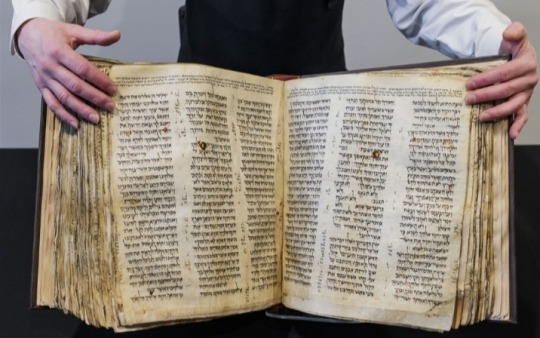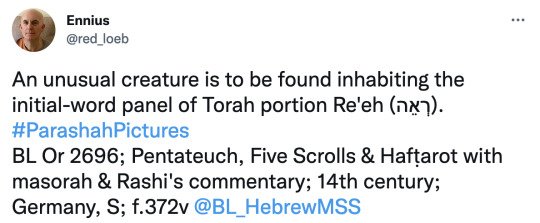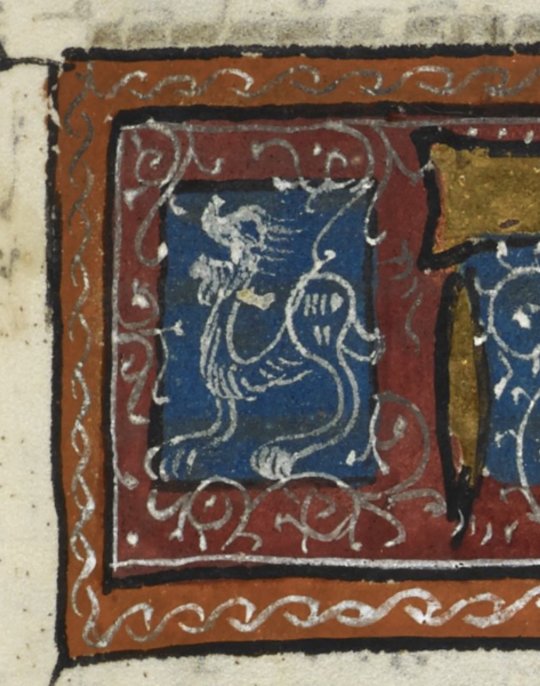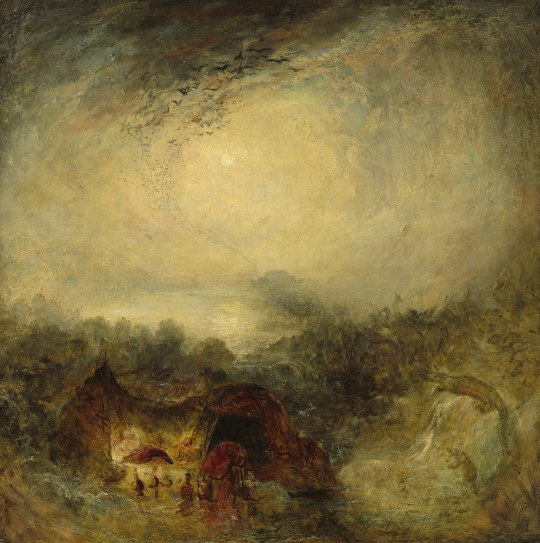#Pentateuch
Text
CAJS Rar Ms 166 is an 18th century copy of the Pentateuch and Historical Books (Joshua, Judges, Ruth, Samuel, Kings and Chronicles) in Arabic translation. Every book has a gorgeous painted heading. Written in Egypt.
🔗:
#manuscript#18th century#arabic#Egyptian#Egypt#bible#pentateuch#illustrated#painted#book history#rare books
47 notes
·
View notes
Text

The Israelites Leaving Egypt, David Roberts, 1828 or 1830
#art#art history#David Roberts#historical painting#ancient history#Ancient Egypt#religious art#Biblical art#Christian art#Christianity#Old Testament#Hebrew Bible#Torah#Pentateuch#Exodus#Book of Exodus#Orientalism#Orientalist#Orientalist art#British art#Scottish art#19th century art#oil on canvas#Birmingham Museum and Art Gallery
194 notes
·
View notes
Text

Here's a picture of Tamar, the pious pretend prostitute (Genesis 38), who I drew for Mother's Day. I started writing up her story, too, but I dramatized it and it got too long and it might just be a novella now?
90 notes
·
View notes
Text

Unicorns and goats and elephants, oh my!
This elephant, in the center of a star of David, appears at the beginning of the Book of Deuteronomy (Devarim) in a highly illuminated copy of the Pentateuch made somewhere in the Holy Roman Empire between about 1300 and 1325.
Some scholars have argued that the artists of this manuscript derived the elephant symbol largely from the influence of Christian artists and writers (who in turn derived much of the symbolism from Late Antique and ancient writers). There are dragons higher up on the page, and the (satanic) dragon fighting the (steadfast and loving) elephant was a major theme in Christian bestiaries, patristics, and other works. However, in "The Elephant and the Law", Marc Michael Epstein argues that there were subtler meanings and that elephants had long-standing symbolism in Jewish art, too. (He points out that elephants do appear in a mosaic on a floor of a synagogue from about 530 AD).
Today, this manuscript is known as the "Duke of Sussex Pentateuch" because it was once owned by Augustus, Duke of Sussex, one of the sons of King George III and Queen Charlotte (of Bridgerton fame).
Date: 1300-1325
Origin: Holy Roman Empire
Now British Library, Add MS 15282, f. 238r

#elephant#elephants#medieval elephants#hebrew manuscript#pentateuch#dragon#unicorn#illuminated manuscript#book history#fourtheenth century
18 notes
·
View notes
Text
About the Pentateuch/Torah
To read the individual books click here
#genesis#exodus#leviticus#numbers#deuteronomy#catholic#catholicism#polls#tumblr polls#theology#bible#holy bible#pentateuch
14 notes
·
View notes
Photo

17 notes
·
View notes
Text

The earliest and most complete Hebrew Bible ever discovered – a “vital touchstone of human history” that dates back more than 1,100 years – is to be sold at auction.
The ninth-century volume, referred to as the Codex Sassoon, is a critical link between the Dead Sea scrolls and the Bible of today.
It is being offered by Sotheby’s with an estimate of $30m-$50m (£25m-£42m), making it the most valuable historical document or manuscript to appear at auction.
Composed of 24 books divided into three parts – the Pentateuch, the Prophets and the Writings – the Hebrew Bible is the foundation of Judaism and other Abrahamic faiths.
In Christianity, the texts are referred to as the Old Testament and are incorporated into the biblical canon.
Islam also holds the stories of the Hebrew Bible in special regard, with many of them included in the Qur’an and other significant works of Islamic literature.

“The Hebrew Bible is the sacred, foundational text for peoples across the globe,” said Sharon Mintz, Sotheby’s senior Judaica specialist.
“For thousands of years, the faithful have closely studied, analysed, mediated on, and delved into the holy scriptures – it is the first book of the people of the Book – to acquire wisdom and attain spiritual enlightenment."
“In Codex Sassoon, a monumental transformation in the history of the Hebrew Bible is revealed, bringing to light the full story of the Hebrew Bible that had previously never been presented in book form.
[It] marks a critical turning point in how we perceive the history of the divine word across thousands of years and is a transformative witness to how the Hebrew Bible has influenced the pillars of civilisation – art, culture, law, politics – for centuries.”
Before the first codices (manuscripts in book form) of the Hebrew Bible, there existed only portions or sections of biblical texts in scroll form.
Known as the Dead Sea scrolls, they date to the third century BC – but they were copied without punctuation or vocalisation and contained no verses or chapters.
This meant the correct reading of the scrolls was not easily apparent; instead Jews in antiquity relied on inherited oral traditions to understand, preserve and transmit the words of the Hebrew Bible.

The Codex Sassoon is named after its prominent modern owner, David Solomon Sassoon (1880-1942), who assembled the most significant private collection of Jewish artefacts and Hebrew manuscripts in the world.
It comes to auction from the collection of Jacqui Safra and will be sold in New York this May.
The record for the most valuable historical text and manuscript sold at auction is held by the first printing of the US constitution, which sold for $43m in November 2021.
While Codex Sassoon has been recognised for its importance by scholars for generations, it has remained virtually out of public view for centuries and will be exhibited for the first time in 40 years next week at Sotheby’s London before a worldwide tour.
The manuscript also includes annotations from several owners throughout the centuries, including an entry dating to the early 11th century referencing a sale by Khalaf ben Abraham, assumed to be a near eastern businessman active in Palestine and Syria, to Isaac ben Ezekiel al-Attar.
In the 13th century or later, the codex was dedicated to the synagogue of Makisin (present-day Markada in north-east Syria).
When the town of Makisin was destroyed, perhaps by the Mongols in the 13th century or by Tamerlane’s troops in 1400, the codex was entrusted to the care of a community member, Salama bin Abi al-Fakhr.
Sassoon ultimately acquired the codex in 1929.
Richard Austin, Sotheby’s global head of books and manuscripts, said Codex Sassoon was “undeniably one of the most important and singular texts in human history.”

This article was amended on 16 February 2023.
The operating area of a presumed 11th century businessman was earlier given as Israel and Syria. Israel (created in 1948) has been changed to Palestine.
#Hebrew Bible#Codex Sassoon#Dead Sea scrolls#Bible#Old Testament#Pentateuch#Prophets#Writings#Qur’an#David Solomon Sassoon#Jacqui Safra#Sotheby’s London
11 notes
·
View notes
Text



8 notes
·
View notes
Text
Is There Encoded Religious Meaning in the "Twelve Days of Christmas"?
Is There Encoded Religious Meaning in the “Twelve Days of Christmas”?
https://www.historicmysteries.com/twelve-days-of-christmas-meaning/

View On WordPress
#Apostles Creed#Bethlehem#bible#Catholicism#Christian holidays#Christianity#Christmas#December 25#England#Epiphany#January 5#January 6#Jesus#Pentateuch#Son of God#Twelve Days of Christmas
2 notes
·
View notes
Text
12 Days of Christmas: A Guide to the Meaning Behind the Carol
12 Days of Christmas: A Guide to the Meaning Behind the Carol
The “Twelve Days of Christmas” is a popular Christmas carol that has been enjoyed by people around the world for centuries. The song tells the story of a series of gifts given by a suitor to his true love on each of the twelve days leading up to Christmas.
The origins of the song are somewhat murky, but it is believed to have originated in England in the 18th century. Some speculate that it was…
View On WordPress
#Apostle&039;s Creed#Beatitudes#Christian symbolism in Christmas music#Christmas carols#Christmas teachings for children#Christmas traditions#Days of creation#Faithful apostles#Fruits of the Holy Spirit#Gift-giving traditions during the holiday season#Gifts of the Holy Spirit#Gospels of the New Testament#History of the Twelve Days of Christmas#Meaning behind Christmas carols#Old and New Testaments#Pentateuch#Ten Commandments#The Twelve Days of Christmas#Theological virtues
2 notes
·
View notes
Text
An informal lunch or coffee time to meet virtually with Kislak curators and talk about one of the manuscripts from Penn's collections. Each week we'll feature a different manuscript and the expertise of one of our curators. Everyone is welcome to attend.
This week's #CoffeeWithACodex on February 8 at Noon EST is CAJS Rar Ms 166, a copy of the Pentateuch and Historical Books (Joshua, Judges, Ruth, Samuel, Kings and Chronicles) written in Arabic in Egypt, 1760. You can register here, or if you've attended CWAC before you can reuse that link and password. Hope to see you there!
#manuscript#18th century#arabic#egypt#bible#pentateuch#historical books of the bible#coffee with a codex#cwac#event#zoom#video
4 notes
·
View notes
Text

The Evening of the Deluge, J.M.W. Turner, ca. 1843
#art#art history#J.M.W. Turner#Joseph Mallord William Turner#landscape#landscape painting#religious art#Biblical art#Christian art#Christianity#Old Testament#Hebrew Bible#Torah#Pentateuch#Book of Genesis#Noah#Noah's Ark#Noah's Flood#Romanticism#Romantic art#English Romanticism#British art#English art#19th century art#oil on canvas#National Gallery of Art
108 notes
·
View notes
Text
Exodus 15:11-14 in Judeo-Greek
טִיש שָאן אֶשֶן אִישְטוּש דִינָאטוּש קִירְײֵ טִיש שָאן אֶשֶן
τις σαν εσέν εις τους δυνατούς κύριε τις σαν εσέν
אָדְרְיוֹמֵנוֹש אִישְטוֹ אָיוֹ פוֹבֵרוֹש טִיש אֶפֵּנֵיש קַמְנִי תַמַגְמָא:
αντρειωμένος εις το άγιο φοβερός τις επαινές κάμνει θάμαγμα
אֶקְלִינֵיש טִיש דֶקְשְײָאשוּ אֵיקָטָפְּײֵטוּש אֶײֵש:
έκλινες την δεξιά σου εκατάπιε τους ηγής
אוֹדֶפְּשִישמֵיְ טִיש אֶלֵיְמוֹשִיְנִישוּ לָאוֹן אֵטוּטוֹן אֶקְשָגוֹרָשֵיש
όδεψες με την ελεημοσύνη σου λαόν ετούτον εξαγόρασες
אֶדִילָגוֹײִשֵיש מֵיטִ דִינָמִישוֹ פְּרוֹש נָאוֹן אָיוֹשִינִישוּ:
εδηλαγώγησες με τη δύναμή σου προς ναόν αγιοσύνη σου
אָקוּשָן לָאִי אֶטְרוֹמַקְשָאן פוֹבוּש אֶפְּײָאשֵין טוּש קַתִיָזמֶנוֹש פְּלָשֶת:
άκουσαν λαοί ετρόμαξαν φοβούς έπιασέν τους καθισμένος Πλασεθ
#Judeo-Greek#yevanic language#yevanitika#hellenic languages#exodus#pentateuch#bible#constantinopolitan pentateuch
3 notes
·
View notes
Text
Live Stream Sunday School - April 24, 2022
Live Stream Sunday School – April 24, 2022
https://www.facebook.com/gaines.melvin/videos/528240628744880
Sunday school session for Akron Alliance Fellowship Church, Akron OH.
Biblical Inerrancy – Session 12 – Transmission (Part 1)

View On WordPress
#2 Kings#biblical inerrancy#chisel#discovery#God#Hebrew#inerrancy#ink#manuscript#Masoretes#Moses#Old Testament#paper#papyrus#pen#Pentateuch#Septuagint#stone#Talmud#Ten Commandments#transmission#video
2 notes
·
View notes
Text
Barry J. Beitzel, ed. Lexham Geographical Commentary on the Pentateuch
Beitzel, Barry J., ed. Lexham Geographical Commentary on the Pentateuch. Bellingham, Wash.: Lexham Press, 2022. xxvi+915 pp.; Hb. $49.99 Link to Lexham Press
Barry Beitzel has a well-deserved reputation in scholarship for his contributions to biblical geography. He edited The New Moody Atlas of the Bible (Moody, 2009; reviewed here). He edited the first volume of this projected six-volume…

View On WordPress
0 notes
Text
And the LORD smelled a sweet savour; and the LORD said in his heart, I will not again curse the ground any more for man's sake; for the imagination of man's heart is evil from his youth; neither will I again smite any more every thing living, as I have done.
Genesis 8:21
0 notes